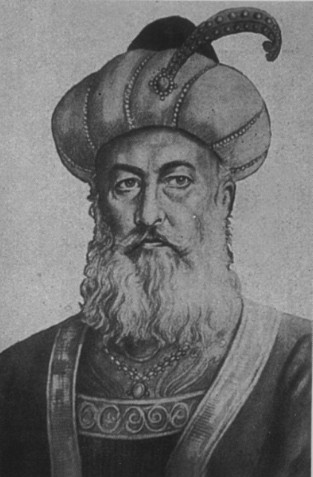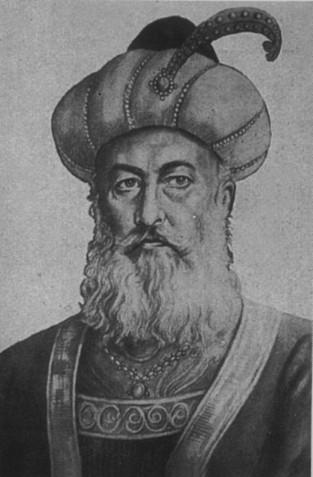The Ghorids who delivered the death blow to the Ghaznavids are a classic example of the sometimes independent, sometimes semi-independent local chieftains to which this discussion has referred so often. Living in the high mountains east of Herat where the rugged terrain discouraged outsiders from all but periodic raids for plunder, slaves or tribute, these chieftains dwelt in heavily fortified villages happily engaging in their personal contests. For-tune was a highly mecurial commodity, however, and the rise or fall of an individual was often determined by the vagaries of mere chance.
It is related, for instance, that during the time of the great Caliph Harun al-Rashid (785-809), of Arabian Nights fame, two chieftains of Ghor decided to settle their dispute over paramountcy by placing their case before the Caliph. Though they both joined the same caravan only one caught the shrewd eye of a Jewish merchant who offered, in return for exclusive trading rights in Ghor, to instruct his awkward travelling companion in the intricacies of the sophisticated court life of Baghdad. His pupil listened well during the long, slow journey and on the day of the audience the chief of the House of Shansab of Ghor moved imperiously through the complicated ceremonies, dressed inagnificently in robes of highest fashion. His rival, on the other hand, appeared in the "short garments which he was accustomed to wear at home," impressing no one. And so, it is written, the "Shansabani received all of the territory of Ghor from Caliph Harun-ar-Rashid." (Juzjani, 1260 A.D.)
The historical accuracy of such tales must, of course, be ques-tioned for when Sultan Mahmud Ghaznavi invaded Ghor in 1009 he found the people to be pagan, but the fickleness of fortune is accurately illustrated and Sultan Mahmud did negotiate with a local Shansabani chief ruling at Ahangaran where prized Ghorid arms were manufactured. By the beginning of the 12th century the Shansabani had extended their authority over the other Ghorid chiefs and their power was such that they stood almost as equals with the Ghaznavids on their southern border and the Seljuks on their northern border. Honoring this strength, Malik al-Jibal "King of the Mountain" laid out the foundations of a great capital city called Firozkoh which some believe to have been at Jam where a magnificent minaret now stands. Malik Qutubuddin was unable, however, to finish his city for he had a falling out with his brothers (he had seven) and was forced to leave for Ghazni where he was well received and well respected until Sultan Bahram Shah (1118-1152), jealous of his increasing popularity, served him with a glass of poisoned sherbet (1146). Fratricidal bickerings at home in Ghor were immediately set aside once this heinous insult became known and a relentless enmity betw&en; Ghor and Ghazni began, to end in the obliteration of the Ghaznavids.
One by one the brothers left their mountain capital with their armies to engage in a complicated series of maneuvers for revenge and counter-revenge: the first brother captured Ghazni and dis-dainfully sent his army back to Ghor whereupon the Sultan re-turned to torture the Ghorid to death; the second brother died on his way to revenge the new death (1149); the third, Alauddin, defeated the Sultan Bahram Shah in the vicinity of modern Kan-dahar (1151). The Sultan fell back in retreat upon Ghazni which "Alauddin took by storm, and during seven nights and days fired the place, and burnt it with obstinacy and wantonness. . . During these seven days, the air, from the blackness of the smoke, continued as black as night; and those nights, from the flames raging in the burning city, were lighted up as light as day. During these seven days likewise, rapine, plunder and massacre were carried out with the utmost pertinacity and vindictiveness." (Juzjani)
Thus Alauddin earned the title of Jahansuz "World Burner". These scenes at Ghazni were repeated several times as the army returned to Ghor; the pleasure villas of Lashkar Gah were gutted, the countryside completely ravaged, and at Firozkoh victory tow-ers were built of Ghazni's soil carried there on the backs of cap-tives whose blood served as mortar.
The founder of Ghorid Dynasty, Ghias-ud-Din Ghori

Turbulent warfare marks the early years of this dynasty and continued until Alauddin's nephew, Ghiyasuddin (1157-1202), was raised to the throne by the Ghorid army. Under his enlightened direction the House of Ghor and the Afghan area at last knew peace and prosperity, at least for a few years. Ghiyasuddin's famous brother, Muizuddin, ruled for him at Ghazni and took Ghorid rule into India, while at Bamiyan his uncle built a great city from which Ghorid authority was spread throughout the northern re-gions of Afghanistan and across the Oxus River as far as Kashghar. At its height the Ghorid Dynasty claimed suzerainty from India to Iraq, from Kashghar to the Persian Gulf.
Ghiyasuddin was an avid builder. The intricately decorated minaret of Jam bears his name as does the arch at the great mosque of Herat, a city he added to his domain in 1175. In this mosque the body of Ghiyasuddin Ghori lies under an unadorned tomb in a special chapel to which the faithful still come to pray.
Rivals to the north, the Khwarizm from south of the Aral Sea, enviously coveted the power and the riches of their Ghorid neigh-bors. As soon as death removed the strong personality of Sultan Ghiyasuddin (1202) they moved. Muizuddin tried valiantly to stem their advance but Balkh (1205) and then Herat (1206) fell before the Khwarizm Shah. Deserted by his followers, Muizuddin fled first to Ghazni, where his officers denied him entrance, and then into India where he was assassinated on the banks of the Indus. Only at Bamiyan, in the heart of the mountains, did the dynasty survive for a short while and then it too succumbed and the last of the Shansabani rulers was taken north to the Khwarizm capital and there put to death in 1215.

Comments